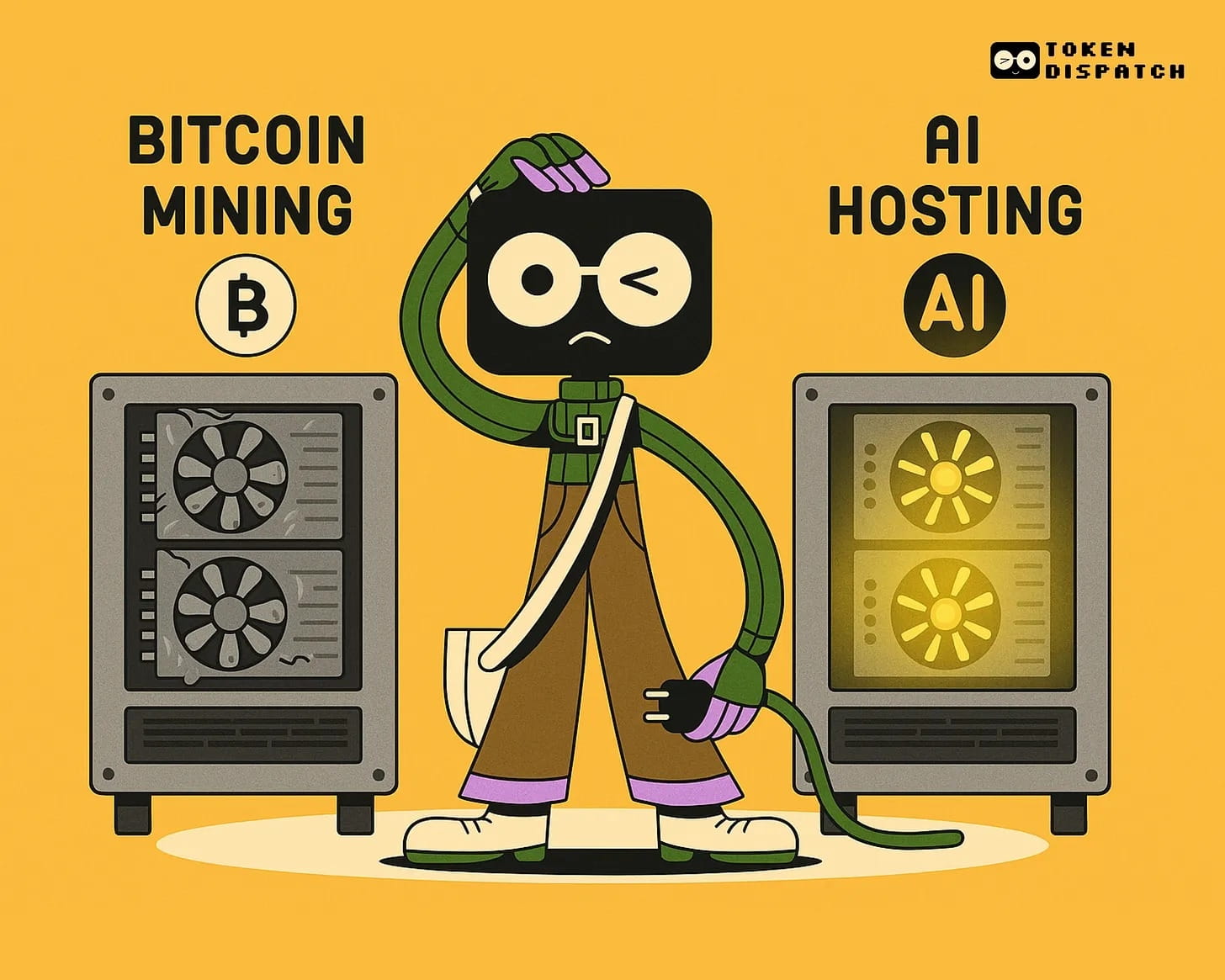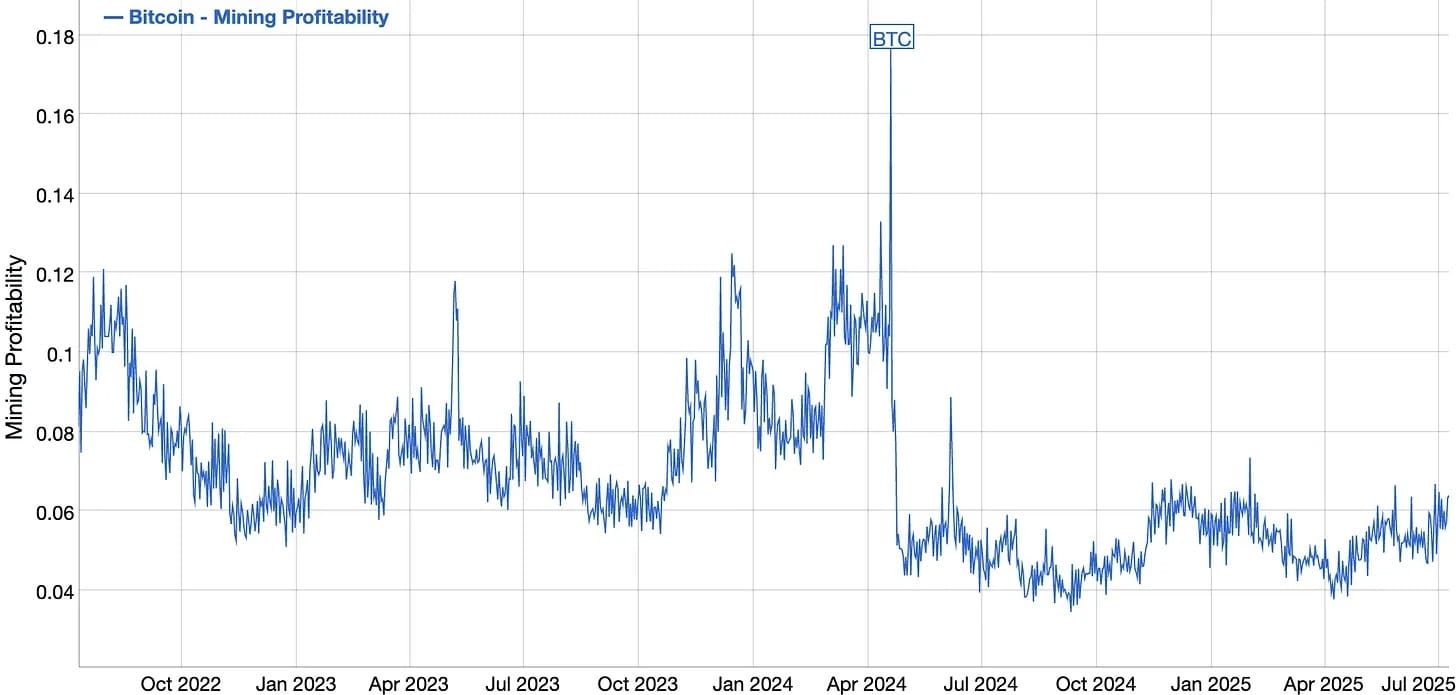Written by: Prathik Desai
Compiled by: Block unicorn

In April 2024, Bitcoin's fourth halving quietly reset the game rules for miners. The reward for each block dropped from 6.25 BTC to 3.125 BTC. Initially, the market did not care. Prices barely fluctuated. But for miners, whose profits were already slim, the math became significantly more difficult overnight.
This means they need to put in the same effort but only receive half the return.
Maintaining the original model means paying for energy costs and upgrading equipment. Some have tried, but most have seen their incomes decline. Mining profitability has dropped from an average of about $0.08 per day (1 terahash/second) to $0.055 per day (1 terahash/second).

Everyone knows the halving is approaching. Most are preparing to pivot their business, stopping the sale of their mined Bitcoin. Unchanging costs with declining income mean reduced profit margins. They are turning to accumulate Bitcoin, betting on its long-term value.
They have not slowed down. Michael Saylor's Strategy (then known as MicroStrategy) has set a template with its bet on Bitcoin.
Marathon has become the largest miner by vault size, adding over 30,000 BTC to its balance sheet in just over a year since the halving. The company has mined at least 8,900 BTC and purchased over 21,000 BTC from the open market.
Riot retained every mined satoshi (about 5,000 BTC) in the 12 months following the halving and purchased over 5,000 BTC during that period. Even Hut 8, with relatively lower output, has added over a thousand BTC since the halving, having sold almost none of its accumulated Bitcoin.
Hive has recovered from the wave of shifting to proof-of-stake (PoS) from Ethereum, with its Bitcoin reserves growing by more than 25% since the halving, and subsequently sold part of its reserves to support expansion. Core Scientific, after emptying its wallet post-bankruptcy, has accumulated more than 900 Bitcoin since the halving, 700 of which came from one quarter. This is unusual for a miner that once sold every coin to survive.
These are not normal behaviors in Bitcoin miners' business, but rather desperate attempts to evolve.
This indicates one thing: accumulating Bitcoin is no longer a stopgap measure. It shows confidence in Bitcoin's rise, but also reveals something else.
Establishing Bitcoin finances helps with long-term price appreciation. However, asset appreciation does not equal income, and it cannot cover daily operating costs.
Post-halving, profit margins have tightened. The cost of mining Bitcoin is higher than ever, and many have realized that the old model—mine, sell, repeat—is no longer viable. Some miners have found that they have the foundation for transformation: facilities built for high-energy machines. They have begun repurposing their infrastructure for AI computing.
Core Scientific took the lead with high-profile actions. In June 2024, it signed a 12-year, $3.5 billion GPU infrastructure hosting agreement with AI cloud provider CoreWeave. This is one of the largest AI hosting deals ever. The contract provides Core with a long-term revenue source that is almost independent of Bitcoin prices and has sparked a quiet competition in the mining sector.
Riot has also taken similar steps. In January 2025, Riot paused its expansion plans for the 600-megawatt Bitcoin mine in Corsicana and began reselling the site to hyperscale data center and AI companies. The company shifted from expanding hashing power to seeking AI tenants. The Corsicana mine was originally designed for expansion, with 1 gigawatt of power and vast space. Riot believes that instead of installing more ASICs, it is better to lease to AI operators.
Hut 8 has chosen a different direction. It has spun off its entire mining division into an independent entity called American Bitcoin, retaining 80% of the shares. This allows the parent company to focus on data center infrastructure and AI services. In September 2024, Hut 8 launched Highrise, a GPU-as-a-service division starting with 1,000 Nvidia H100s, and signed a five-year contract with a cloud customer. Earlier this year, it announced the establishment of a 300-megawatt high-performance computing park in Louisiana.
Hive, with its long history of GPU mining prior to Ethereum's merge, is relying on its traditional advantages. It has repurposed over 4,000 old GPUs for cloud computing, then deployed H100 and H200 clusters in Quebec. By early 2025, Hive's annual revenue run rate from AI reached $20 million, with plans to reach $100 million the following year. It sold some Bitcoin in 2024 but retained most of what it mined that year.
Even Marathon, the most steadfast supporter of Bitcoin, has adjusted its direction. In September 2024, it appointed two veterans from the AI industry to its board. The company developed immersion cooling systems designed specifically for AI inference workloads. By early 2025, the company began exploring data center hosting services for AI clients. As of May 2025, the company held over 49,000 Bitcoin. Since April 2024, it has sold almost none of its mined Bitcoin.
Iris Energy is betting heavily on artificial intelligence. It has sold all mined Bitcoin and is fully expanding its data centers. By mid-2025, it has deployed over 4,000 GPUs and is building facilities in Texas and British Columbia to accommodate 20,000 GPUs. Although funding remains scarce, its infrastructure is rapidly developing.
Some miners view Bitcoin as a strategic reserve. Others see it as a liquid inventory to support growth. But in any case, they are trying to extend the same assets—cheap land, idle energy, grid access, and specialized cooling systems—into areas that are more useful than just mining.
Just relying on mining is no longer sufficient for survival.
Electricity prices have not changed. Hashrate continues to rise. Surviving miners have achieved this by increasing optionality. Some have become service providers, some have become cloud computing providers, and many are still experimenting to find solutions.
Currently, most miners are still mining Bitcoin. But it's no longer the entire business. It's just one of many revenue streams that may include AI hosting, GPU leasing, energy brokering, and even sovereign-level computing infrastructure in the future.
It is still too early to assess whether miners' shift to AI will be successful, and the data is too sparse. Although high-performance computing (HPC) businesses have not yet fully expanded for everyone, the profit margins for AI computing per megawatt are significantly higher than for mining, which helps.
For some, it has begun to show some signs.
Iris Energy's AI service revenue grew from negligible to $2.2 million by June 2025. This relatively new business segment has a profit margin of 98%, while the mining business has a profit margin of 75%.
However, this is not a foolproof strategy. Building AI facilities is costly. Not only is power needed, but also networking, redundancy, cooling, and customers that can continuously fill the racks. Not every miner can succeed. Some will overbuild, some will miss market opportunities, and some will still rely entirely on Bitcoin years later.
The industry is no longer singular.
They started with stacking blocks. Then they began to accumulate Bitcoin. Now, they are stacking GPUs. However, Bitcoin mining has not stopped.
Most miners turning to artificial intelligence are still mining Bitcoin.
Last month, Bitcoin's hashrate reached an all-time high, far exceeding levels at the time of the halving. This indicates increased mining difficulty and costs, as miners need to invest more computing resources to solve blocks and earn rewards.
In this scenario, it becomes economically unfeasible for companies to sell mined Bitcoin at lower profit margins. Unless Bitcoin prices rise or transaction fees soar, only the most efficient operations can be profitable.
Increasing efficiency may mean lowering power and computing costs. It may even mean holding Bitcoin, only selling when prices far exceed the average level post-halving. This explains why most miners are turning to AI for higher returns on investment.

